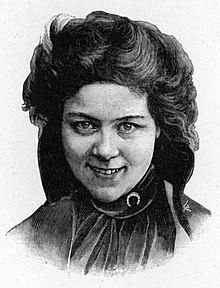Toulouse-Lautrec became famous for his bold images of nightclub performers
‘Divan Japonais’ (1893) by Henri de Toulouse-Lautrec. PHOTO: MUSEUM OF FINE ARTS, BOSTON
Henri de Toulouse-Lautrec (1864-1901) was the Andy Warhol of late 19th-century Paris—a chronicler of celebrity and nightlife who mixed high art with popular culture. It’s little wonder that he is so popular in our own celebrity-obsessed age: Toulouse-Lautrec exhibitions recently took place in Edinburgh and Barcelona, and a big show is scheduled for Paris this fall. Now Americans will have a chance to experience his work thanks to “Toulouse-Lautrec and the Stars of Paris,” a new show opening April 7 at the Museum of Fine Arts in Boston, which focuses on the cabaret dancers and singers whom the artist celebrated.
Most fans of Toulouse-Lautrec know these performers only as names on his classic posters, but the exhibition fleshes out their stories. Here are Jane Avril, a dancer who rose from humble beginnings thanks to her jerky style, a product of her movement disorder; singer Aristide Bruant, famous for his raffish get-up, outsider persona and songs about the poor; and Loïe Fuller, an American who was celebrated in Paris as a pioneer of modern dance.
Toulouse-Lautrec grew up in southern France in a family that could trace its roots back to the era of Charlemagne. He suffered a congenital disease that caused his legs to be underdeveloped—he stood about 5 feet tall—and suffered from frequent pain. Possibly as a result, he became addicted to the highly alcoholic drink absinthe—he reportedly stored it in his walking stick—which further damaged his health, and he died at the age of 36.
‘Jane Avril’ (1893) PHOTO: MUSEUM OF FINE ARTS, BOSTON
But Toulouse-Lautrec made the most of his brief career. A 1970s catalog of his works includes some 6,000 illustrations. As a student in Paris, he fell for modern artists—the impressionists and post-impressionists—as well as for the demimonde of the nightclubs. Toulouse-Lautrec wasn’t the first to paint the amusements of Paris—the show includes depictions of theatergoers, singers and musicians by artists such as Degas, Cassatt and Sargent. But Toulouse-Lautrec’s style set him apart when his promotional posters for Montmartre nightclubs began to decorate kiosks and walls all over Paris.
Besides solid art-school training, says the exhibition’s curator Helen Burnham, his style incorporated elements of the acerbic caricatures of Daumier and the bold shapes, vivid colors and abrupt juxtapositions of Japanese woodblock-print artists like Hiroshige and Utamaro, whose work spread across Europe in the last decades of the 19th century. Viewers can compare the rather sedate 1871 Degas painting of “Racehorses at Longchamp,” with the jockeys seen from the back, to Toulouse-Lautrec’s portrait of a jockey furiously urging on his horse in an 1899 lithograph.
‘Aristide Bruant in his Cabaret’ (1893) PHOTO:MUSEUM OF FINE ARTS, BOSTON
The second half of the exhibition focuses on pictures of the stars. As Ms. Burnham writes in the catalog, Toulouse-Lautrec boldly experimented “to capture the look that defined a performer in the public eye, while focusing on the person as much as on the role.” His posters for the cabaret run by Bruant distilled not only the singer’s look “but also his message or brand,” writes Mary Weaver Chapin. That brand included Bruant’s trademark snarl—he’d hurl insults at the audience—as well as his red scarf and black cape. “The flat areas of broad color” and simple outlines “lend an unpolished and spontaneous aspect to these sophisticated posters,” Ms. Chapin writes.
Toulouse-Lautrec did something equally stylized for Loïe Fuller.

In her “serpentine dance,” which made her a star in Paris around 1892, she wore an enormous billowing skirt that she manipulated with wands sewn into the hem, as colored lights bathed her from both sides of the stage. (Fuller tried to patent her dance, but law of the time wouldn’t allow it.) While the Bruant posters aimed at a mass audience, Toulouse-Lautrec produced his 1893 Fuller lithograph for collectors. He had about 60 impressions made of the original lithograph, which was created by drawing on stone with a wax pen and then preparing the image chemically for printing. Each print has a unique set of colors that make Fuller appear as an almost amorphous, butterfly-like creature.

Not from article: Fuller image (and bio) from Wikipedia
In her “serpentine dance,” which made her a star in Paris around 1892, she wore an enormous billowing skirt that she manipulated with wands sewn into the hem, as colored lights bathed her from both sides of the stage. (Fuller tried to patent her dance, but law of the time wouldn’t allow it.) While the Bruant posters aimed at a mass audience, Toulouse-Lautrec produced his 1893 Fuller lithograph for collectors. He had about 60 impressions made of the original lithograph, which was created by drawing on stone with a wax pen and then preparing the image chemically for printing. Each print has a unique set of colors that make Fuller appear as an almost amorphous, butterfly-like creature.
Among his star subjects, only one was personally close to the painter: Jane Avril, a courtesan’s daughter who took to the stage in the late 1880s. For the short-lived nightclub Divan Japonais (“Japanese sofa”), Toulouse-Lautrec created a poster depicting Avril in the audience, while another star, Yvette Guilbert, performs onstage. But Avril isn’t looking at the stage—she seems to be listening to an audience member beyond the poster’s frame —and the lithograph’s perspective seems unstable and full of motion. It’s not surprising that, Ms. Burnham says, Toulouse-Lautrec strongly influenced the rule-breaking Picasso.
No comments:
Post a Comment